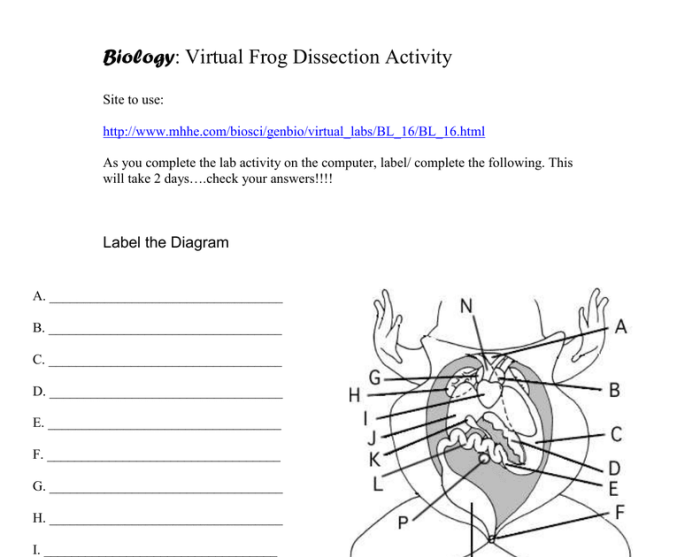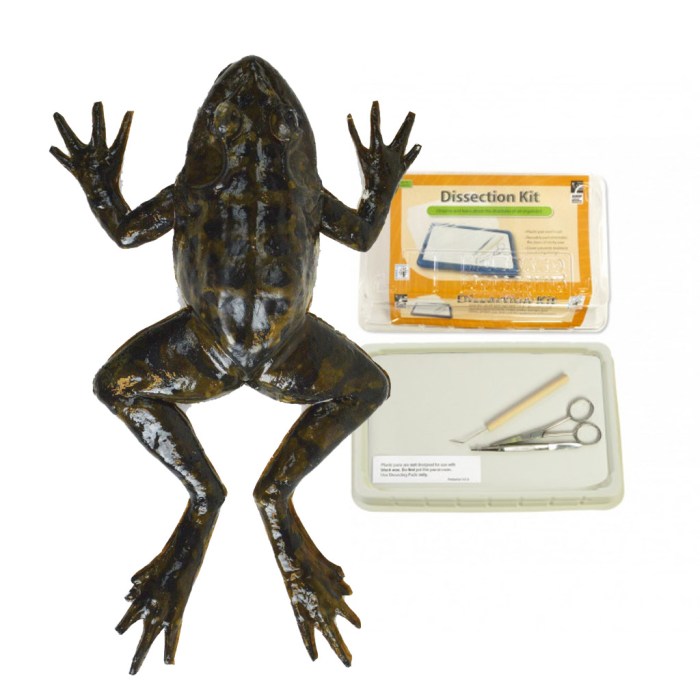The frog dissection coloring answer key serves as an invaluable tool for students embarking on the intricate exploration of frog anatomy. This comprehensive guide empowers learners to grasp the complexities of amphibian biology through the engaging medium of color-coded diagrams.
Delving into the depths of frog dissection, students encounter a symphony of anatomical structures, each meticulously labeled and described within the coloring key. This visual aid illuminates the intricate tapestry of organs, muscles, and systems that orchestrate the life of these fascinating creatures.
1. Overview of Frog Dissection Coloring Answer Key

A frog dissection coloring answer key is an essential tool that provides a visual guide to the anatomy of a frog. It helps students identify and understand the various anatomical structures of a frog, making it a valuable resource for biology and anatomy education.
The coloring answer key is typically provided alongside a frog dissection diagram, which students can use to color-code different anatomical structures based on their function or location. This process helps students visualize and retain information about frog anatomy, enhancing their understanding of the subject matter.
2. Key Anatomical Structures

The frog dissection coloring answer key typically labels and describes the following key anatomical structures:
- Skin:The outer layer of the frog’s body, which provides protection and helps regulate body temperature.
- Muscles:The muscles of the frog allow it to move, jump, and swim.
- Skeletal System:The bones of the frog provide support and protection for its body.
- Digestive System:The organs involved in the frog’s digestion, including the mouth, esophagus, stomach, small intestine, and large intestine.
- Respiratory System:The organs involved in the frog’s respiration, including the lungs and skin.
- Circulatory System:The heart and blood vessels of the frog, which transport blood throughout the body.
- Nervous System:The brain and nerves of the frog, which control its movements, senses, and behavior.
- Reproductive System:The organs involved in the frog’s reproduction, including the testes or ovaries and reproductive ducts.
3. Coloring s and Tips: Frog Dissection Coloring Answer Key
The frog dissection coloring answer key provides specific s for coloring the different anatomical structures. These s may vary depending on the key, but typically include:
- Color-coding:Different anatomical structures are assigned specific colors to help students distinguish between them. For example, muscles may be colored red, bones may be colored yellow, and the digestive system may be colored green.
- Labeling:The key may also provide labels for each anatomical structure, which can be written directly on the diagram or in a separate legend.
- Arrows or lines:Arrows or lines may be used to connect different anatomical structures or indicate their relationship to each other.
4. Assessment and Evaluation
The frog dissection coloring answer key can be used as an assessment tool to evaluate students’ understanding of frog anatomy. By comparing students’ colored diagrams to the answer key, teachers can assess their accuracy and knowledge of the subject matter.
The answer key can also help students self-assess their work and identify areas where they need further study.
5. Educational Benefits
Using a frog dissection coloring answer key has several educational benefits, including:
- Enhanced visualization:Coloring the diagram helps students visualize the different anatomical structures and their relationships to each other.
- Improved retention:The process of coloring and labeling the diagram helps students retain information about frog anatomy more effectively.
- Increased understanding:By comparing their colored diagrams to the answer key, students can identify areas where they need further understanding.
- Scientific inquiry:The coloring answer key can spark students’ curiosity and encourage them to ask questions about frog anatomy.
- Critical thinking:Students must use critical thinking skills to analyze the diagram and determine the appropriate colors and labels for each anatomical structure.
6. Supplementary Resources
In addition to the frog dissection coloring answer key, there are a number of other resources that can complement students’ learning, such as:
- Websites:There are several websites that provide interactive frog dissection simulations and videos, such as the National Geographic Frog Dissection Virtual Lab.
- Videos:YouTube and other video-sharing websites offer a variety of educational videos on frog anatomy and dissection.
- Books:There are a number of books available that provide detailed information on frog anatomy, such as “The Frog: A Guide to Its Anatomy and Physiology” by Robert W. Hill.
Questions and Answers
What is the purpose of a frog dissection coloring answer key?
A frog dissection coloring answer key provides students with a visual guide to the anatomical structures of a frog, aiding in their understanding and identification during dissection.
How does color-coding enhance the learning experience?
Color-coding different anatomical structures helps students distinguish and memorize their functions and locations more effectively.
Can the coloring answer key be used for assessment?
Yes, the coloring answer key can serve as an assessment tool to evaluate students’ understanding of frog anatomy and their ability to apply color-coding principles.